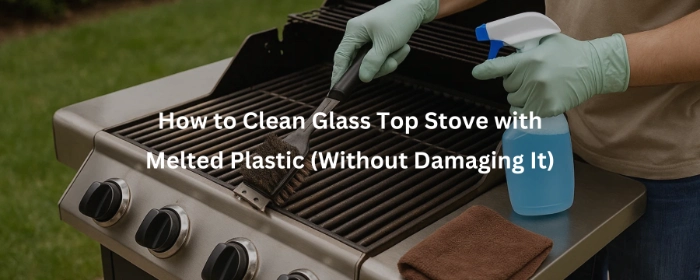How to Clean Glass Top Stove with Melted Plastic (Without Damaging It)

-
Let the Stove Cool Completely First
-
Gently Scrape Off Hardened Plastic
-
Use Baking Soda and Vinegar to Remove Residue
-
For Stubborn Plastic: Try a Freezer Trick
-
Finish with a Stove Cleaner or Polish
-
What Not to Do
-
Final Thoughts
Disclosure: Some of the links in this article may be affiliate links, which can provide compensation to me at no cost to you if you decide to purchase. This site is not intended to provide financial advice and is for entertainment only.
A melted plastic mess on your glass stove top can feel like a disaster.
It smells bad, looks worse, and if you're not careful, it can permanently damage your cooktop.
But don’t worry — there’s a safe and simple way to clean it up without scratching the surface or spreading the mess.
Here's how to remove melted plastic from a glass top stove the right way.
Let the Stove Cool Completely First
Before you touch anything, wait until the stove is fully cool.
Trying to clean while the surface is still hot can make the melted plastic smear more or even cause burns.
Be patient — this is key to avoiding permanent marks or injuries.
If plastic melted while cooking, turn off the burner immediately and don’t touch it until it’s room temperature.
Gently Scrape Off Hardened Plastic
Once cooled, the plastic should be firm, not sticky.
The best way to remove it is with a plastic, wooden, or brass scraper — never use a metal knife, steel wool, or razor unless it’s specifically made for glass stoves.
An excellent tool for this job is the Easy Function Wood Grill Scraper.
While it's designed for BBQ grills, it works wonders on glass stovetops because it’s tough on grime, but safe on smooth surfaces.
Just press gently at a 45° angle and lift off the plastic bits.
Use Baking Soda and Vinegar to Remove Residue
Once you’ve scraped most of the plastic away, you might notice a thin film or stain left behind.
Don’t scrub it with a scouring pad.
Instead, do this:
Sprinkle baking soda on the affected area.
Pour a little white vinegar over it.
Let the fizzing action sit for 5–10 minutes.
Wipe it off with a soft cloth.
This method is safe for glass and helps lift plastic residue without scratching.
Learn More About the Wonders of This Combo Here: How to Clean a Glass Top Stove With Vinegar and Baking Soda (Safely and Easily)
For Stubborn Plastic: Try a Freezer Trick
If some melted plastic still won’t budge, grab a few ice cubes.
Place them in a zip bag and set it on top of the melted area for 15 minutes.
The cold makes the plastic brittle and easier to chip off with your scraper.
Avoid using cold water directly — it can cause sudden temperature changes and crack the glass.
Finish with a Stove Cleaner or Polish
After all the plastic is removed, use a glass stove top cleaner to restore the shine.
If you don’t have one, a bit of dish soap and warm water on a microfiber cloth will work just fine.
Buff in circular motions, then dry completely.
What Not to Do
Don’t use sharp knives or metal blades unless made for glass cooktops.
Don’t try to clean while hot.
Avoid harsh chemicals like oven cleaner or bleach.
Don’t scrub with steel wool or abrasive sponges.
These things can leave scratches, dull the finish, or create permanent stains.
Final Thoughts
Melted plastic on your glass stove top isn’t the end of the world.
With the right tools and steps, you can clean it off safely and make your cooktop look like new.
If you want a safe scraper that works just as well for grill grates and stovetops, click the image below to check out our Easy Function Grill Scraper.
Looking for more tools to make BBQ and kitchen cleanup easier?
Explore our full range of products for grilling, smoking, and temperature control.
-
Let the Stove Cool Completely First
-
Gently Scrape Off Hardened Plastic
-
Use Baking Soda and Vinegar to Remove Residue
-
For Stubborn Plastic: Try a Freezer Trick
-
Finish with a Stove Cleaner or Polish
-
What Not to Do
-
Final Thoughts
Disclosure: Some of the links in this article may be affiliate links, which can provide compensation to me at no cost to you if you decide to purchase. This site is not intended to provide financial advice and is for entertainment only.
